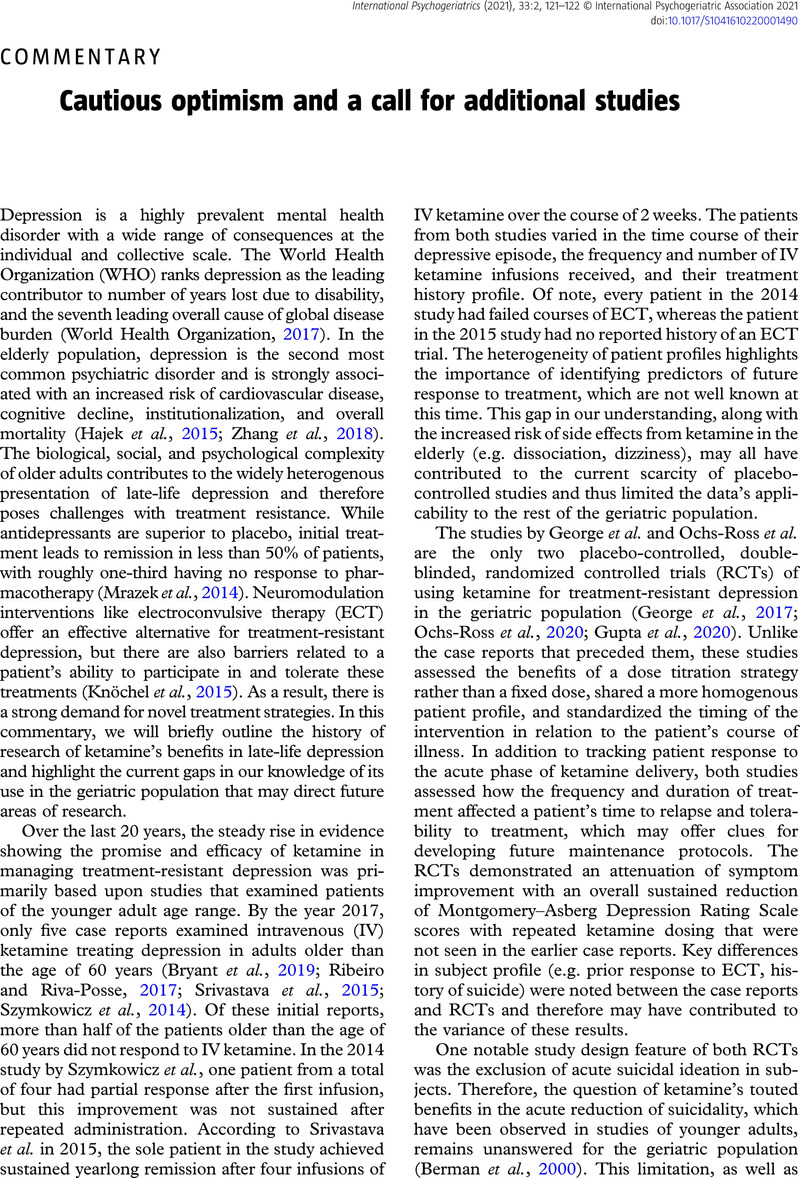No CrossRef data available.
Article contents
Cautious optimism and a call for additional studies
Published online by Cambridge University Press: 10 March 2021
Abstract
An abstract is not available for this content so a preview has been provided. Please use the Get access link above for information on how to access this content.

- Type
- Commentary
- Information
- International Psychogeriatrics , Volume 33 , Special Issue 2: Issue Theme: Schizophrenia and Depression in Older Adults , February 2021 , pp. 121 - 122
- Copyright
- © International Psychogeriatric Association 2021
References
Berman, R. M. etal. (2000). Antidepressant effects of ketamine in depressed patients. Biological Psychiatry, 47, 351–354.CrossRefGoogle ScholarPubMed
Boström, G. etal. (2016). Antidepressant use and mortality in very old people. International Psychogeriatrics, 28, 1201–1210. doi: 10.1017/S104161021600048X
CrossRefGoogle ScholarPubMed
Bryant, K. A., Altinay, M., Finnegan, N., Cromer, K. and Dale, R. M. (2019). Effects of repeated intravenous ketamine in treatment-resistant geriatric depression. Journal of Clinical Psychopharmacology, 39, 158–161.CrossRefGoogle ScholarPubMed
Conwell, Y., Van Orden, K. and Caine, E. D. (2011). Suicide in older adults. Psychiatric Clinics of North America, 34, 451–68.CrossRefGoogle ScholarPubMed
George, D. etal. (2017). Pilot randomized controlled trial of titrated subcutaneous ketamine in older patients with treatment-resistant depression. The American Journal of Geriatric Psychiatry, 25, 1199–1209.CrossRefGoogle ScholarPubMed
Hajek, A. etal. (2015). Longitudinal predictors of institutionalization in old age. PLoS One, 10, e0144203
CrossRefGoogle ScholarPubMed
Knöchel, C. etal. (2015). Treatment-resistant late-life depression: challenges and perspectives. Current Neuropharmacology, 13, 577–591.CrossRefGoogle Scholar
Mrazek, D. A., Hornberger, J. C., Altar, C. A. and Degtiar, I. (2014). A review of the clinical, economic, and societal burden of treatment-resistant depression: 1996–2013. Psychiatric Services, American Psychiatric Association, Arlington, VA, 65, 977–987.CrossRefGoogle ScholarPubMed
Ochs-Ross, R. etal. (2020). Efficacy and safety of ketamine nasal spray plus an oral antidepressant in elderly patients with Treatment-Resistant Depression-TRANSFORM 3. The American Journal of Geriatric Psychiatry, 28, 121–141.CrossRefGoogle ScholarPubMed
Ribeiro, C. M. and Riva-Posse, P. (2017). Use of ketamine in elderly patients with treatment-resistant depression. Current Psychiatry Reports, 19, 107.CrossRefGoogle Scholar
Srivastava, S., Gangwar, R. S. and Kumar, A. (2015). Safety and efficacy of ketamine infusion in late onset depression, and conversion to treatment response. Indian Journal of Psychiatry, 57, 328–329.CrossRefGoogle ScholarPubMed
Szymkowicz, S. M., Finnegan, N. and Dale, R. M. (2014). Failed response to repeat intravenous ketamine infusions in geriatric patients with major depressive disorder. Journal of Clinical Psychopharmacology, 34, 285–286.CrossRefGoogle ScholarPubMed
Tampi, R. etal. (2020). A systematic review of ketamine for the treatment of depression among older adults. International Pyschogeriatrics. To be published.Google Scholar
World Health Organization (2017). Depression and other common mental disorders. Institutes of Health National, 1, 1–22.Google Scholar
Zhang, Y., Chen, Y. and Ma, L. (2018). Depression and cardiovascular disease in elderly: current understanding. Journal of Clinical Neuroscience, 47, 1–5. doi: 10.1016/j.jocn.2017.09.022
CrossRefGoogle ScholarPubMed




